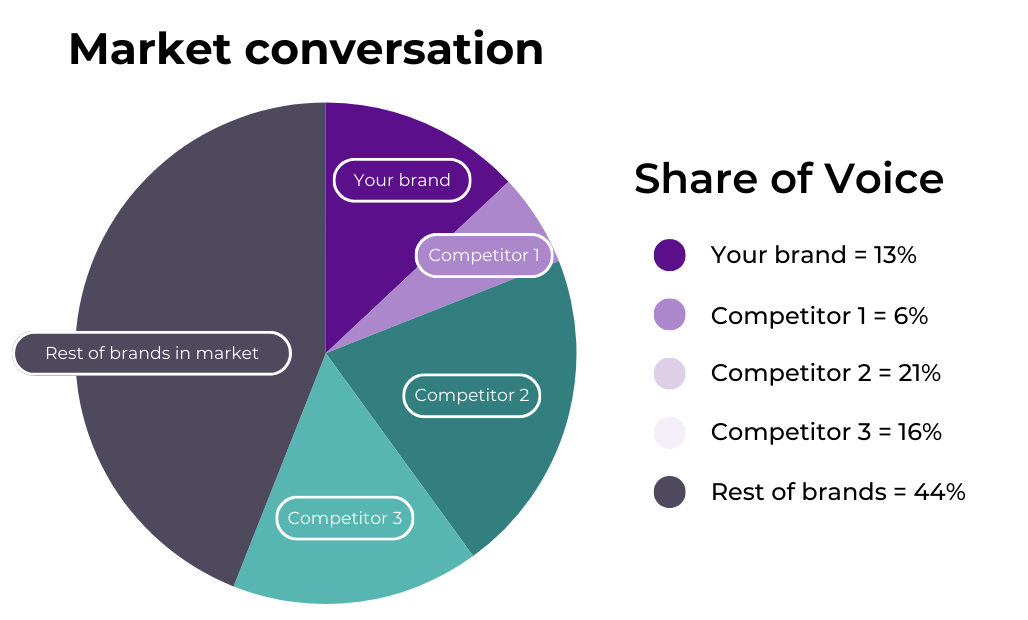Share of Voice: What it is, why it matters and how to increase it
As brands compete on a massive scale to attract consumer attention, understanding and improving Share of Voice (SOV) can be the key to winning the competition and driving brand growth.
Until now, this metric has gone unnoticed, and was basically used to measure the success of paid advertising campaigns. But SOV is a very versatile metric that serves many purposes. It can be used in competitive analysis on organic traffic or social media, as well as for paid advertising.
According to a Nielsen study, a 10% increase in Share of Voice can generate a 0.5% growth in a brand’s market share, so this metric should be given all the value it deserves.
In this guide, we will explore what Share of Voice is, what makes it different from Share of Market, how to calculate it, and the best strategies for increasing it.
What is Share of Voice?
Share of Voice is a fundamental concept in marketing and advertising, which measures a brand’s share of the total market conversation. In simple terms, it represents a brand’s visibility and dominance compared to its competitors within a specific segment or industry. SOV covers different communication channels, including traditional media such as television and radio, as well as digital media such as social media, online advertising and mentions in blogs.

In online Retail, Share of Voice consists of a series of very specific metrics that detail a brand’s online presence in search results, both organic and paid (e.g. through Retail Media). There are thousands of relevant keywords where brands can appear and, thanks to them, achieve a better online presence.
Evaluating these metrics and the keywords that lead them to appear in more searches allows brands to understand their position in the market and evaluate the effectiveness of their marketing strategies. A high SOV indicates a greater presence and recognition of the brand among the target audience, which can translate into increased consideration and, eventually, sales growth.
Share of Voice vs. Share of Market
It’s common to confuse Share of Voice with Share of Market (SOM), but these concepts, although related, have significant differences. While SOV refers to the proportion of a brand’s visibility in the advertising market, SOM refers to a brand’s share of the total sales volume of a market.
Share of Voice focuses on how much is being said about your brand or how visible it is compared to the competition, while Share of Market measures how much your brand sells compared to other market players. The relationship between these two concepts is crucial: SOV acts as a predictor, but it does not guarantee a larger market share. By monitoring Share of Voice, companies can ensure that their product listings on e-commerce receive the right attention from potential customers.
How is Share of Voice calculated?
Calculating Share of Voice involves measuring a brand’s presence compared to the other players present in the market within a specific period of time. The basic formula for calculating SOV is:

Impressions can vary depending on the channel and medium. For example, in digital advertising, impressions can be ad views, while on social media they can be mentions or interactions. To get an accurate view of SOV, it is important to gather data from all relevant channels and add it together to get total market impressions.
Ways to measure it by channel
Share of Voice can be measured across multiple channels, each with its own metrics and tools. Here are the most common ways to measure SOV across different channels:
1. Traditional Media
For television, radio and print media, SOV is measured in terms of advertising space purchased or airtime.
2. Digital Advertising
On platforms such as Google Ads or LinkedIn Ads, Share of Voice is measured in impressions or clicks. These platforms provide detailed reports showing the performance of ads compared to the competition.
3. Social Media
SOV on social media is measured through mentions, hashtags, comments and shared posts. Tools like Hootsuite, Sprout Social and Brandwatch can help track these metrics and compare brand activity with that of its competitors.
4. SEO and Organic Search
Here, Share of Voice can be measured through search traffic share and ranking in results.
5. Earned Media
For press articles and blogs, SOV is measured through mentions and quotes. Media monitoring tools can track media coverage and calculate brand participation compared to other market players.
6. Presence on the Digital Shelf (in online retail)
Another way to measure Share of Voice in online retail is by measuring presence on the Digital Shelf, which would be equivalent to measuring Digital Share of Shelf. As we explained in a previous article, Digital Share of Shelf measures the proportion of space or visibility that a brand has in online stores, e-commerce platforms and other digital channels.
7. Presence on shelves (in physical retail)
Finally, we can’t forget about the physical shelf. Similar to what is measured in Digital Share of Shelf, in the physical realm, we will measure the proportion of space that a brand occupies on the shelves of physical stores.
Why is it important for brands to measure it?
Measuring Share of Voice is crucial for brands for several reasons:
Evaluating strategies
It allows brands to evaluate the effectiveness of their marketing campaigns and adjust their strategies to improve visibility.
Competitive positioning
It helps to understand the brand’s position in the market compared to its direct competitors, which is vital for identifying opportunities and threats.
Performance metrics
Provides a tangible metric for measuring brand performance over time, facilitating data-driven decision making.
Improving market share
As we explained at the beginning of this post, a high SOV could lead to a higher Share of Market, as visibility directly influences consumer consideration and purchase decisions.
Consumer insights
Analysing Share of Voice helps to better understand how consumers perceive the brand and how engaged they are with it compared to the competition.

How can you increase your brand’s Share of Voice?
Increasing Share of Voice requires a combination of well-planned and executed strategies. Here are some effective tactics:
1. Increase advertising investment
Investing more in advertising can increase impressions and your brand’s visibility. It is crucial to distribute this investment in a balanced way across the most relevant channels.
2. Content optimisation
Creating relevant, high-quality content that resonates with your audience can increase mentions and engagement on social media and earned media. This article explains how to optimise your product listings with quality content.
3. Improve SEO
Optimising content for search engines increases organic visibility and long-term traffic, which contributes to increased Share of Voice.
4. Public relations campaigns
Running effective public relations campaigns can generate media coverage and mentions, increasing SOV in earned media.
5. Collaborations and sponsorships
Partnering with influencers, celebrities or relevant events can significantly increase brand visibility and generate a higher Share of Voice.
6. Continuous monitoring and adjustment
Using monitoring tools to track SOV and adjust strategies in real time as needed to maximise visibility and effectiveness.
Monitoring your Share of Voice and your Digital Share of Shelf for many different keywords, products and campaigns can be very time-consuming, leaving your teams with no energy to perform other equally important tasks. The most effective way to control these metrics is to use a market analytics tool like flipflow. This platform automatically gathers data from your business’s advertising, both organic and paid, and its powerful BI tool creates visualisation dashboards in seconds. With these reports, where you can also integrate your company’s proprietary data, your entire team will be equipped with the information needed to grow your business exponentially.
Conclusion
Share of Voice is an essential metric for any business looking to understand and improve its market position. By measuring and analysing SOV, brands can evaluate the effectiveness of their marketing strategies, identify growth opportunities and adjust their tactics to maximise their visibility.
Increasing Share of Voice requires a combination of investment in advertising, creating quality content, search engine optimisation and continuous monitoring. By doing so, brands will ensure a greater presence in the minds of consumers and, ultimately, the possibility of increasing their market share.



